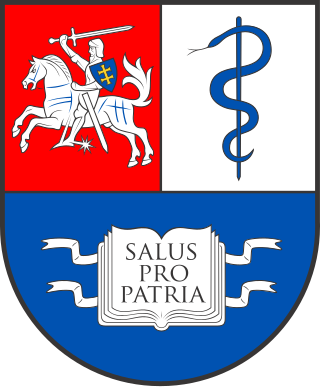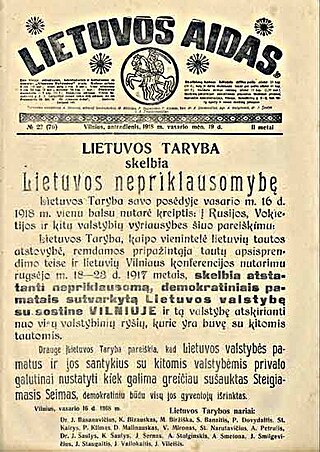
Lithuania, officially the Republic of Lithuania, is a country in the Baltic region of Europe. It is one of three Baltic states and lies on the eastern shore of the Baltic Sea. Lithuania shares land borders with Latvia to the north, Belarus to the east and south, Poland to the south, and Russia to the southwest. It has a maritime border with Sweden to the west on the Baltic Sea. Lithuania covers an area of 65,300 km2 (25,200 sq mi), with a population of 2.8 million. Its capital and largest city is Vilnius; other major cities are Kaunas and Klaipėda. Lithuanians belong to the ethno-linguistic group of the Balts and speak Lithuanian, one of only a few living Baltic languages.

Lithuanian University of Health Sciences is a medical school in Kaunas, Lithuania. The present-day Lithuanian University of Health Sciences is a consolidation of two institutions of higher education, Kaunas University of Medicine and the Lithuanian Veterinary Academy. It uses the Hospital of Lithuanian University of Health Sciences Kaunas Clinics and the Kaunas Red Cross Hospital as teaching hospitals.

The Palace of the Grand Dukes of Lithuania is a palace in Vilnius, Lithuania. It was originally constructed in the 15th century for the rulers of the Grand Duchy of Lithuania and the future Kings of Poland. The palace, located in the lower castle of Vilnius, evolved over the years and prospered during the 16th and mid-17th centuries. For four centuries the palace was the political, administrative and cultural centre of the Polish–Lithuanian Commonwealth. It was demolished in 1801. Work on a new palace started in 2002 on the site of the original building and it took 16 years to complete it in 2018. The palace was rebuilt in Renaissance style to match the Cathedral of Vilnius and, according to the testimony of one of the couriers of Bona Sforza, such initial reconstruction from 1520 to 1530 cost 100,000 gold ducats and was ordered by Sigismund I the Old. It is believed that the reconstruction was made for the proclamation ceremonies of Sigismund II Augustus, the only son of Sigismund I the Old, as the Grand Duke of Lithuania.

The Vilnius Castle Complex is a group of cultural, and historic structures on the left bank of the Neris River, near its confluence with the Vilnia River, in Vilnius, Lithuania. The buildings, which evolved between the 10th and 18th centuries, were one of Lithuania's major defensive structures.
Edmundas Antanas Rimša is a Lithuanian historian, specialist of heraldics, sfragistics and genealogy.

The first known record of the name of Lithuania is in a 9 March 1009 story of Saint Bruno recorded in the Quedlinburg Chronicle. The Chronicle recorded a Latinized form of the Old Church Slavonic word for Lithuania—Литва (Litva)—Latinized as Litva. Although it is clear the name originated from a Baltic language, scholars still debate the meaning of the word.

Lietuvos aidas is a daily newspaper in Lithuania. It was established on September 6, 1917 by Antanas Smetona, and became the semi-official voice of the newly formed Lithuanian government. When the government evacuated from Vilnius to the temporary capital, Kaunas, it ceased publication. The newspaper was revived in 1928 as the newspaper of the Lithuanian government and became the most popular newspaper in Lithuania. At its peak, it published three daily editions with combined circulation of 90,000 copies. World War II disrupted its publication. In 1990, after Lithuania declared independence from the Soviet Union, the newspaper once again became the official newspaper of the Supreme Council of the Republic of Lithuania. At the end of 1992, its circulation reached 103,000 copies. However, it was soon privatized and faced shrinking readership, financial difficulties, and other controversies. In April 2006, bankruptcy proceedings were initiated by the State Tax Inspectorate when its tax debts reached more than 4 million litas. The company was liquidated in 2015, but the newspaper continues to be published by a non-profit organization.

The Kaunas pogrom was a massacre of Jews living in Kaunas, Lithuania, that took place on 25–29 June 1941; the first days of Operation Barbarossa and the Nazi occupation of Lithuania. The most infamous incident occurred at the garage of NKVD Kaunas section, a nationalized garage of Lietūkis, an event known as the Lietūkis Garage Massacre. There several dozen Jewish men, allegedly associates of NKVD, were publicly tortured and executed on 27 June in front of a crowd of Lithuanian men, women and children. The incident was documented by a German soldier who photographed the event as a man, nicknamed the "Death Dealer", beat each man to death with a metal bar. After June, systematic executions took place at various forts of the Kaunas Fortress, especially the Seventh and Ninth Fort.

Alvydas Nikžentaitis is a Lithuanian historian, senior research fellow of the Lithuanian Institute of History and president of Lithuanian National Historians Committee.
Lietuvos istorijos metraštis is an academic journal covering the history of Lithuania published by the Lithuanian Institute of History. From 1971 to 2000 it was published once a year; since 2001 it is published twice a year. It is published in Lithuanian with summaries provided in English or German.
History of Lithuania or Academic History of Lithuania is a thirteen-volume series of books dedicated to the history of Lithuania. Its first volume was published in 2005, and its last volume is scheduled for publication in 2011. After its completion it will be the largest and the most comprehensive academic publication covering Lithuania's history ever released. As of 2011 five volumes had been released.

Alfonsas Eidintas is a historian, diplomat and novelist. He is Lithuania's Ambassador to Greece.

The Lithuanian Academy of Sciences or LMA is a state-funded independent organization in Lithuania dedicated for science and research. Its mission is to mobilize prominent scientists and initiate activities that would strengthen the welfare of Lithuania and contribute to the scientific, social, cultural and economic development of the country.

Kaunas Fortress is the remains of a fortress complex in Kaunas, Lithuania. It was constructed and renovated between 1882 and 1915 to protect the Russian Empire's western borders, and was designated a "first-class" fortress in 1887. During World War I, the complex was the largest defensive structure in the entire state, occupying 65 km2 (25 sq mi).
Jonas Totoraitis was a Roman Catholic priest and historian.

Veiveriai Teachers' Seminary was a seminary in Veiveriai, Suwałki Governorate, Congress Poland. It was established as teachers' courses in 1866 and reorganized into a seminary in 1872. It prepared teachers for elementary schools in the Suwałki Governorate. During World War I, the seminary was evacuated into Russia and subsequently disbanded. During its existence, the seminary prepared 1,025 teachers, some of which later became prominent figures in Lithuanian education, politics, and culture.

The Genocide and Resistance Research Centre of Lithuania is a state-funded research institute in Lithuania dedicated to "the study of genocide, crimes against humanity, and war crimes in Lithuania; the study of the persecution of local residents by occupying regimes; the study of armed and unarmed resistance to occupying regimes; the initiation of the legal evaluation of the activities of the organisers and implementers of genocide; and the commemoration of freedom fighters and genocide victims." The centre was founded on 25 October 1992 by the Supreme Council of the Lithuanian Republic as the "State Genocide Research Centre of Lithuania". It is a member organisation of the Platform of European Memory and Conscience.
Vasilijus Safronovas is a Lithuanian historian. Throughout his writings he explores modern cultural and intellectual history of Lithuania and former region of East Prussia, with particular interest to former Territory of Memel/ Klaipėda.
Česlovas Laurinavičius is a Lithuanian historian and politologist, In 2003, he was the recipient of the Knight's Cross of the Order for Merits to Lithuania. Since 2001, he has served as the head of the Department of the 20th Century History at the Lithuanian Institute of History.













